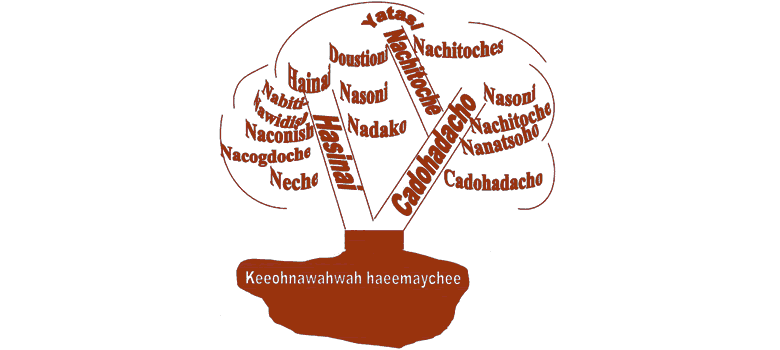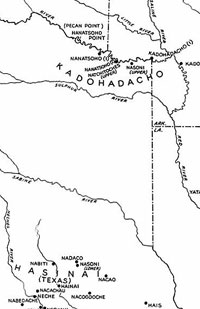
John Swanton's map showing the approximate
locations of some of the named Caddo groups and villages,
as recorded by the Spanish and French in the late 1600s
and early 1700s. From: Source Material on the History
and Ethnology of the Caddo Indians, 1942, Smithsonian
Institution.
|
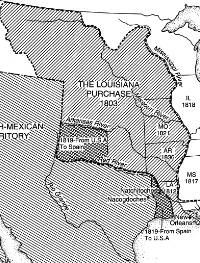
No boundaries were mentioned in the
terms of the 1803 Louisiana Purchase. The boundary between
Louisiana and the Spanish dominions remained uncertain
until defined by the 1819 treaty negotiated by the U.S.
Secretary of State and the Spanish Minister in Washington.
From Carter, 1995, Caddo Indians: Where We Come From.
|
|
Caddo history begins with The Old People, "Kee-oh-na-wah'-wah
ha-ee-may'-chee", who settled in the valley of Red River
and uplands traced by tributaries draining into the river.
In that place, The Old People became strong and prosperous,
increasing in number and occupying greater territory. Descendants
of the Old People say—Caddo people are like the "limbs
and the twigs."
The first historical documents, written by Spanish
and French explorers in the mid-1500s and late 1600's, describe
individually named communities of Caddo, some quite large
and others mere farmsteads. Interrelated communities were
identified as belonging to one of three geographically separate
branches of the Caddo nation: Cadohadacho along the great
bend in Red River, Natchitoches farther down Red River where
the present Louisiana city of that name stands, and Hasinai,
"Our People," in east Texas. Over time, "hadacho"
meaning sharp was dropped from Cadohadacho and the people
were simply called Cado or Caddo. Spanish officials heard
about "the great kingdom of Tejas" before introducing
themselves to the Hasinai late in the 17th century. The name
for the State of Texas comes from this Spanish spelling of
a Caddo word "taysha," that means "friend"
or "ally".
[Prior to 1874, the word Caddo (or Cado) referred
to the Cadohadacho. Depending on context, we use "Caddo"
to mean Cadohadacho and, more generally, to mean all of the
Caddo-speaking peoples. For most references to historical
events prior to the late 1800s, it means Cadohadacho. By the
early 1800s many formerly independent named groups had joined
up with the Cadohadacho and all were often referred to as
the Caddo.]
Caddo leaders were skillful in arranging peaceful
alliances with neighboring Indian groups. Their powerful influence
and political astuteness became historically and politically
significant during the eighteenth and nineteenth centuries
when their homeland became a borderland between Louisiana
Territory and Spanish-Mexican Territory called the Province
of Texas. Spanish missionaries, military leaders, and government
officials, French traders and governors, Mexican and American
Presidents and officials vied for their support.
From the beginning of relations with Americans
in the early 1800s, Caddos pledged and worked to keep a policy
of peace and friendship with the United States. Exactly nine
years after the signing of the Louisiana Purchase in 1803,
Louisiana was admitted as the eighteenth state of the Union.
Dehahuit, the Grand Caddo, a leader whose influence and leadership
extended beyond Caddo, Natchitoches, and Hasinai to allied
tribes, was soon invited to a meeting with the first American
Governor of Louisiana, William C. Claiborne. Saying that he
spoke for the President, Claiborne asked for the continued
friendship of the Caddo people and emphasized that the current
disagreement between the United States and Spain was a dispute
between white people. He urged, "Let the red man keep
quiet, and join neither side." Dehahuit's cautious response
granted his loyalty but not his lands to the Americans.
|
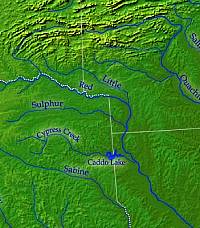
Rivers and terrain of the Caddo Homeland.
|
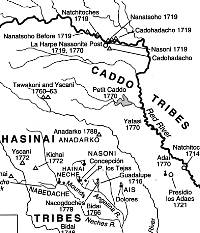
Caddo(Cadohadacho), Hasinai, and
closest neighbors in the eighteenth century. From Carter,
1995, Caddo Indians: Where We Come From.
|
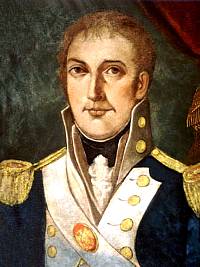
William C. Claiborne, first American
Governor of Louisiana. Portrait in the Louisanana State
Museum.
|
|
|
| |
You request that our wars in future may be
against the deer only, that is what we ourselves desire, and
happen what will, our hands shall never be stained with white
man's blood. Your words, which I have this day heard, shall
be imprinted on my heart, they shall never be forgotten, but
shall be communicated from one to another, till they reach
the setting sun. . . .
My father was a chief; I did not
succeed him till I was a man in years. I am now in his place,
and will endeavor to do my duty, and see that not only my
own nation, but other nations over whom I have influence,
shall properly conduct themselves.
Grand Caddo Dehahuit's
reply to Louisiana Governor Claiborne's address, 1806
|
|
|
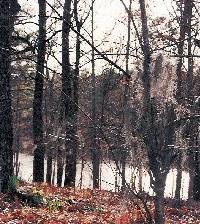 View from Stormy Point. Photo by Cecile
Carter.
View from Stormy Point. Photo by Cecile
Carter. |
Strong and gifted Caddo leadership was not enough
to overcome epidemics that killed thousands, or the flood
of immigrants that came to their homelands as the United States
advanced its western frontier.
Early in 1835, Caddo leaders signed, by marks,
a memorial addressed to the President of the United States.
Written for them in formal English language, the message may
or may not have been approved by the Caddo leaders. Parts
at least were true to their sentiment—"heavy news"
had put the Caddo "in great trouble." Their last
American agent had told them he was no longer their agent
and said he "does not know what will be done with or
for the Caddo." Having placed their faith in assurances
by representatives of the United States that no white man
would ever settle on Caddo lands for more than thirty years,
it is doubtful that the leaders of the Caddo nation now intended,
or even knew, that the final paragraph offered "all our
lands" for sale.
|
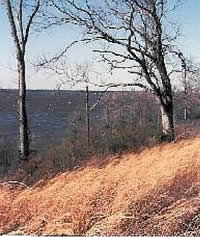
Stormy Point on Ferry Lake (Caddo Lake)
February 1993. There is a good possibility that the Grand
Caddo Dehahuit, who died in 1835, was buried near Stormy Point,
a favorite crossing to Shreveport as late as the 1860s. Photo
by Cecile Carter.
|
|
| |
To his excellency
the President of the United States:
The memorial of the undersigned,
chiefs and head men of the Caddo nation of Indians, HUMBLY
REPRESENTS:
That they are now
the same nation of people they were, and inhabit the same
country and villages they did, when first invited to hold
council with their new brothers, the Americans, thirty years
ago; and our traditions inform us that our villages have been
established where they now stand ever since the first Caddo
was created, before the Americans owned Louisiana; the French
and afterwards the Spaniards, always treated us as friends
and brothers. No white man ever settled on our lands, and
we were assured they never should. We were told the same things
by the Americans in our first council at Natchitoches, and
that we could not sell our lands to any body but our great
father the President. Our two last agents, Captain Grey and
Colonel Brooks, have driven a great many bad white people
off from our lands; but now our last-named agent tells us
that he is no longer our agent, and that we no longer have
a gunsmith nor blacksmith, and says he does not know what
will be done with us or for us.
This heavy news
has put us in great trouble; we have held a great council,
and finally come to the sorrowful resolution of offering all
our lands to you which lie within the boundary of the United
States, for sale, at such price as we can agree upon in council
one with the other.
|
|
|
| |
After waiting six months for a response from
the President, the Caddos received a message that their former
agent was at the agency house (near present Shreveport) and
ready to negotiate with them. There was no true negotiation.
The Caddo had no official counsel. Their former agent made
it clear—Caddo people could sell the land of their forefathers
for what the government now offered or wait only a short time
for the white people to take it away without payment.
|
|
|
| |
I...am again sent...to obtain that
from you which is of no manner of use to yourselves, and which
the whites will soon deprive you of, right or wrong, and am
ready to give for it what you cannot otherwise obtain, or
long exist without, in this or any other country. I am instructed
to deal liberally with you.
U.S. Agent, Jeheil Brooks
June 25, 1835
|
|
|
| |
Thus coerced, Caddo chiefs, headmen, and warriors
drew their marks by names pointed out to them at the Treaty
signing on July 1, 1835.
|
|
|
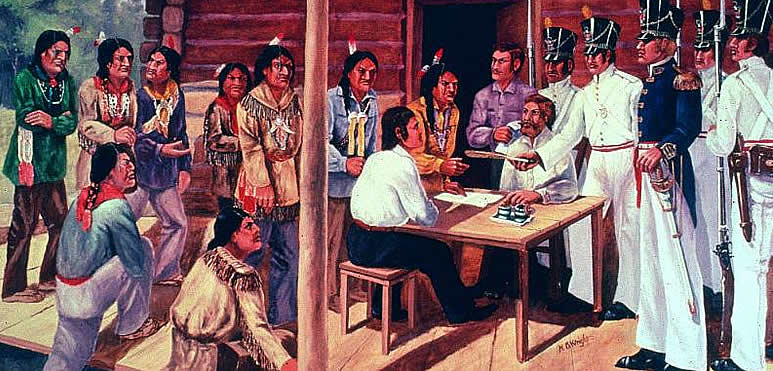
Caddo Indian Treaty of Cession, July 1, 1835.
Mural in Louisiana State Exhibit Museum, Shreveport, courtesy of
Louisiana Department of Culture, Recreation, and Tourism.
|
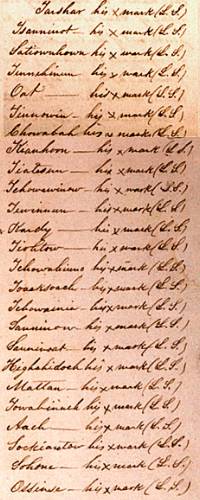
Marks of Caddo chiefs, headmen, and warriors
on the Caddo Indian Treaty of Cession, July 1, 1835. Click
to see entire signature page of treaty.
|
The Caddos gave up nearly a million acres of
ancestral land. According to the Treaty, they would receive
$80,000-thirty thousand in goods and horses on signing the
Treaty, $10,000 in money within one year, and $10,000 in money
each of the following four years. In exchange, the Caddos
were required to move "at their own expense out of the
boundaries of the United States and the territories belonging
and appertaining thereto" within the period of one year
after signing the treaty, and "never more return to live,
settle, or establish themselves, as a nation, tribe, or community
of people, within the same."
For what do you morn? Are you not starving
in the midst of this land? And do you not travel far from
it in quest of food? The game we live on is going further
off, and the white man is coming nearer to us; and is not
our condition getting worse daily? Then why lament for the
loss of that which yields us nothing but misery? Let us
be wise, then, and get all we can for it, and not wait till
the white man steals it away, little by little, and then
gives us nothing...
Tarshar (Ta'sha)principal Caddo
leader speaking to his grief stricken people before the
cession of Caddo lands in 1835
|
Tarshar his X mark
Tsauninot his X mark
Satiownhown his X mark
Tennehinun his X mark
Oat his X mark
Tinnowin his X mark
Chowabah his X mark
Kianhoon his X mark
Tiatesun his X mark
Tehowawinow his X mark
Tewinnun his X mark
Kardy his X mark
Tiohtow his X mark
Tehowahinno his X mark
Tooeksoach his X mark
Tehowainia his X mark
Sauninow his X mark
Saunivoat his X mark
Highahidock his X mark
Mattan his X mark
Towabinneh his X mark
Aach his X mark
Sookiantow his X mark
Sohone his X mark
Ossinse his X mark
|
|
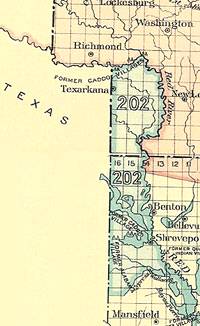
The Caddo nation gave up nearly one million
acres of ancestral land by the Treaty with the United States
in 1835. Sections showing Caddo land cession in 1835 Treaty
outlined and designated 202 on Louisiana and Arkansas maps,
Indian Land Cessions in the United States compiled
by Charles C. Royce,1897, Smithsonian Institution, Bureau
of American Ethnology.
|
...the Indians were asked for an amount
of land large enough to be covered by a hide. After the
bargain the hide was cut into thin strips and stretched
around a large plot of land and claimed as per agreement....the
whites raided the Indians, drove them from their villages
and took a portion of their crops. After the treaty a part
of the money was paid, but a part never was paid.
testimony of Mary Inkinish,
Fort Cobb, Oklahoma, August 25th, 1929
Mary Inkinish was a child when her family left
Louisiana but her memory of the move remained strong. In 1929,
when she was past 100 years of age and the oldest member of
the Caddo Indian tribe, she recalled things that happened
during and after the 1835 Treaty. She did not speak English.
One of her sons interpreted as she told how the Caddos did not
understand the extent of the land sold, and that the money
was never paid as it should have been.
The Caddos moved to different places at different
times. The first to leave looked for new homes in Texas. Mary
Inkinish was with a smaller group that traveled into Mexico
before rejoining the Caddos in Texas. The last to leave followed
Red River to Washita River in Indian Territory (now Oklahoma)
without entering Texas. All were virtually homeless for the
next twenty years.
|
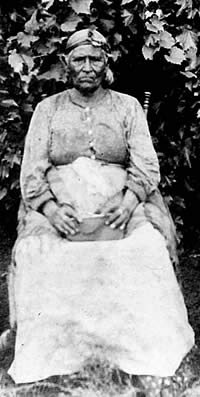
Mary Inkinish retained strong memories
of events during and after the 1835 Treaty when she was past
100 years of age. Courtesy Western History Collection, University
of Oklahoma Library.
|
|
